Episode 1 – What Happens in the Soil When We Reduce Tillage?
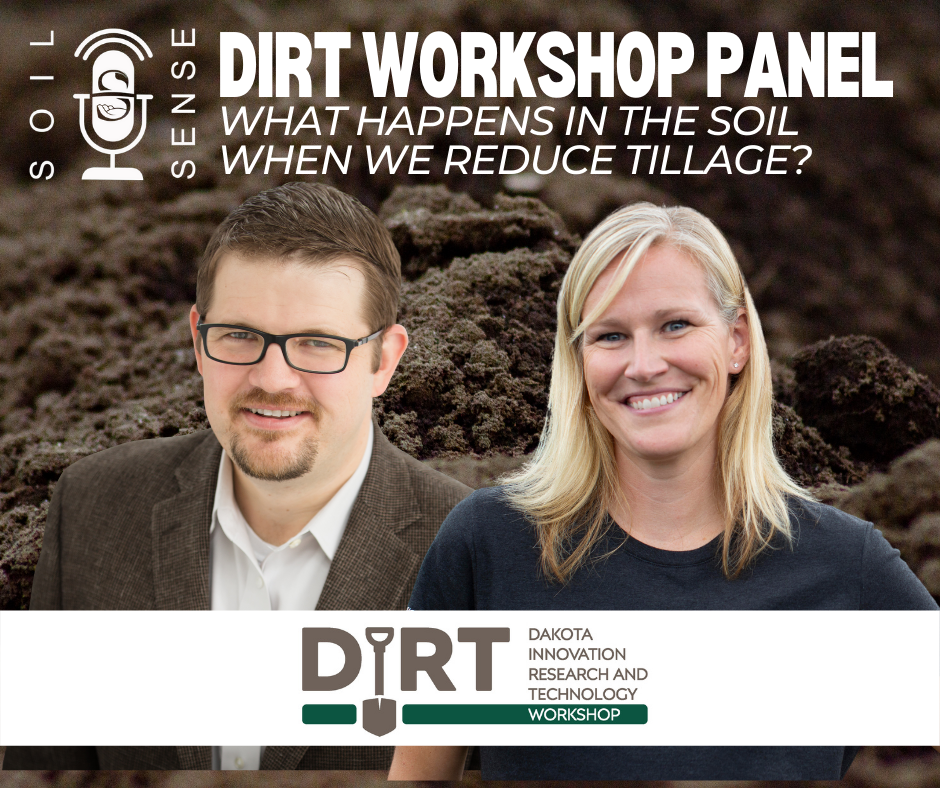
The DIRT Workshop was held virtually this past December. Because the event was held virtually we were able to gain access to some great speakers and panelists that inspired very important discussion. The result is some of the best information out there about soil health, all concentrated in one event. We have recorded some outstanding audio from that event that I think will be tremendously valuable to include in this podcast. Today’s episode focuses on tillage. You’ll hear from:
Anthony Bly, a South Dakota State University Soils Field Specialist and farmer who went full no till back in 1992 about some of the changes he’s seen both on his farm and others. Dr. Aaron Daigh, a soil physicist with North Dakota State University about what’s physically happening to the soil when it is tilled and what changes if we stop. Dr. Caley Gasch, a soil ecologist with North Dakota State University, who will share about what happens with soil biology when we reduce tillage.
“That’s the age old question that we’ve heard for many years as well, “I can’t do that here”…….I know because I’ve seen it that these practices will work with about any soil situation but it takes adherence to the soil health principles.” – Anthony Bly
Anthony goes on to share examples of different soil types that have found success in the soil health principles including his own. He explains his experience with making the adjustment on his own operation and the journey he has seen including “the soil is just stronger.” He shares that farmers are concerned that it may be too hard for a crop to grow but it provides the support, soil biology and water filtration that benefit the crops greatly.
“We have research that shows it can be done and what the constraints are when you change to a new system. We work to try to figure out how do we get past some of those restraints but there’s plenty of folks around….that are doing it right now and have been doing it for quite some time and quite successfully.” – Dr. Aaron Daigh
Dr. Daigh suggests that it took time for the technology to catch up with the no till practice and we are there now. He does allow that there are many variables from one operation to the next which will form the expectations that are possible on what timeline in different areas. The overall goal of increased production with decreased inputs is possible with adjustments for each individual type of soil. Ultimately preserving the aggregates and structure of the soil allows for better water and air penetration which leads to better availability for the crops. “Tilling for the purpose of drying the soil, you might get a wee bit of drying there but you’re working backwards on your drainage.”
“The natural tendency of a soil is to develop that beautiful structure and host so much biological activity that can translate to producing a healthier crop.” – Dr. Caley Gasch
After reducing tillage Dr. Gasch recommends cover crops to improve soil quality. “Plants are the foundation of the soil food web…..and so having growing plants is the next most important thing after you reduce your tillage.” As a soil ecologist Dr. Gasch focuses her efforts on the changes in soil biology with decreased tillage and use of cover crops. She suggests feeding your soils with organic material such as residue or manure. She does not feel microbial testing is necessary for each producer, rather, monitoring for symptoms of biological activity is sufficient.
Connect with Soil Sense:
Soil Sense Podcast is hosted by Tim Hammerich of the Future of Agriculture Podcast.
Episode 2 – DIRT WORKSHOP PANEL: Cover Crops Research and Strategy
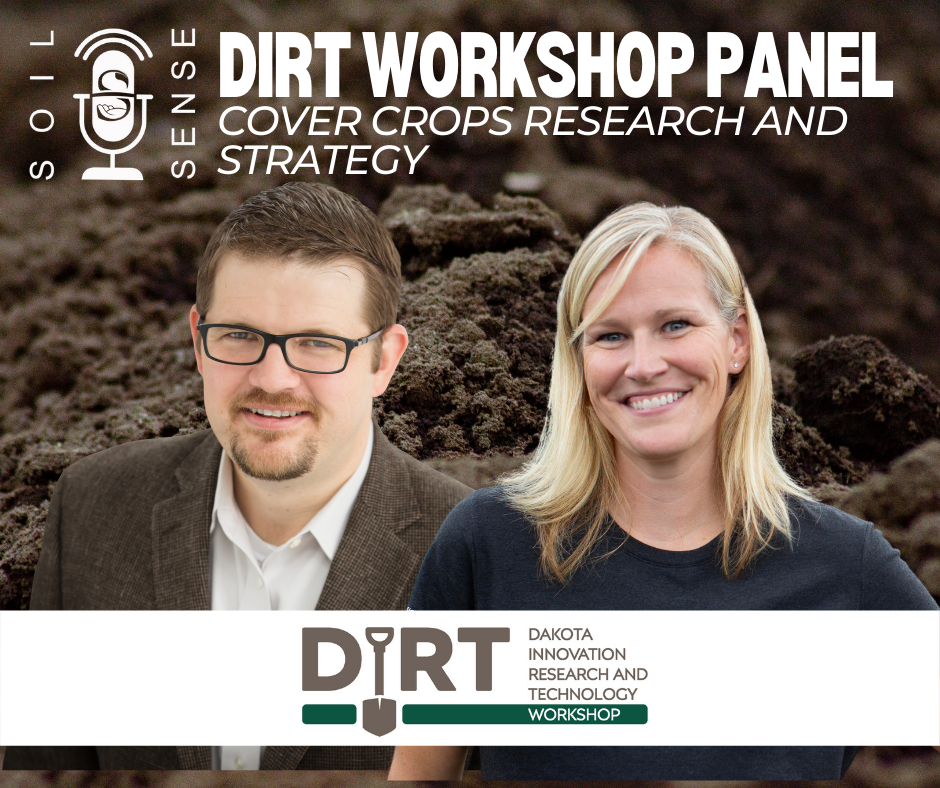
We were able to capture some of the best information out there about soil health at the DIRT Workshop last December thanks to some fantastic speakers and some tremendous audience engagement.Today’s episode focuses on cover crops. You’ll hear from:
Dr. Hans Kandel, a South Dakota State University Professor and Extension Agronomist
Dr. Matt Ruark, a soil scientist from the University of Wisconsin at Madison
Dr. Dave Franzen, a professor and extension soil health specialist also at North Dakota State University
“There is not one cocktail or species that does best. It depends really on the wishes of the producer but there are many opportunities.” – Dr. Hans Kandel
Dr. Kandel prefers to think about using cover crops as a “mimicking of nature.” Multi-species growth is a natural occurrence in the prairie region so growing multiple species simultaneously is naturally supported by the ecosystem. He explains that different cover crops are better suited for different outcomes. If you are looking for something to be sustained throughout the winter then a winter hardy crop like winter rye, winter wheat or camelina may be the best fit. For added nitrogen, peas may work best. Another consideration may be susceptibility to potential disease transfer. Mixes of species have the potential of achieving multiple goals but they also add the concern that you may be watering down some specific benefits by adding more plants that will compete for the same resources. Ultimately the main priority for the producer helps inform the best cover crop and the best timing and method for seeding.
“What gets me the most excited about evaluating cover crops is trying to get the use of legumes in rotation because it does have that short term economic benefit of supplying some nitrogen.” – Dr. Matt Ruark
Dr. Ruark focused his discussion on the benefits of biomass with legumes and how to best manage their growth. “That’s the trick with legumes….for me the legumes are strictly a biomass game….The more biomass you have the more nitrogen release you have.” Of course sometimes that biomass can be overwhelming. Dr. Ruark suggests that you can either use excess biomass as a forage source, you can terminate early to reduce the amount of biomass produced or you can adjust your nitrogen fertilizer application. He does highlight that we are still at the “mercy of the weather patterns, especially in the spring” for growth of cover crops after harvest so control is never absolute.
“I think just being aware and knowing that you’ve got to manage the thing instead of just let it grow until you plant. You have to keep your eyes open and use some common sense when you have cover crops in the west.” – Dr. Dave Franzen
Connect with Soil Sense:
Soil Sense Podcast is hosted by Tim Hammerich of the Future of Agriculture Podcast.
Episode 3 – DIRT WORKSHOP PANEL: Farmer Experiences with Wide Row Corn
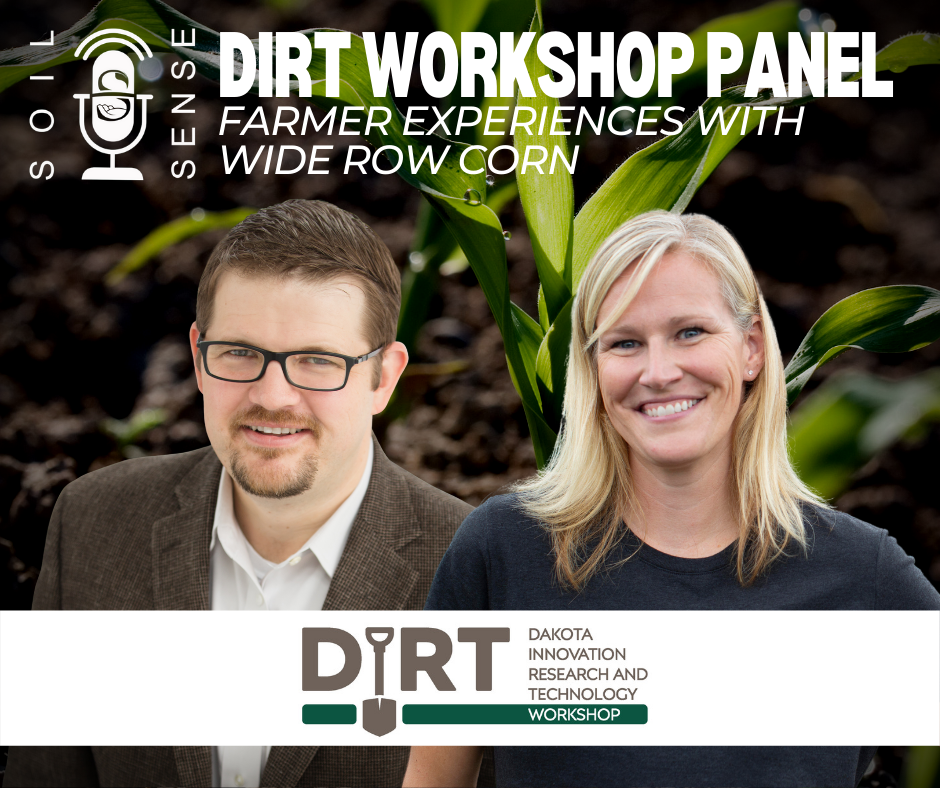
60” corn has been a hot topic in many soil health circles. This wider row spacing can allow for greater light penetration and improve the environment for interseeded cover crop growth. We hosted both a farmer panel and a researcher panel on 60” corn at the DIRT Workshop this past December. In this episode, farmers discuss their system, what yield differences they’ve seen, timing and harvesting considerations, grazing value, crop insurance, and more. To meet these producers and watch the panel discussions click the links below to find the NDSU soil health Youtube channel.
- Joe Breker, farmer from Rutland, North Dakota
- Chris Walberg, farmer/rancher from Leonard, North Dakota
- Tyler Zimmerman, farmer from Leaonard, North Dakota
Also on this panel was Mike Schaefer, who actually planted a full vegetable garden between corn rows on a small plot in New Rockford, North Dakota. We don’t get into that full story today, but I encourage you to check out his video on Youtube.
“It isn’t that the broad pass covers or interseeding covers didn’t work. It just wasn’t as consistent for the following year as I would like to see….I have never had a consistent cover as I have right now going into winter.” – Joe Breker
Joe shares that in spreading out his rows, adding cover crops and applying more fertilizer he did not see a large yield reduction in the cash crop. His goal going forward is to improve weed control by adjusting his cover crop mixture without affecting the yield further. Chris Walberg’s goals in widening his rows was to add species diversity and a grazing program to his operation. This further highlights the advice from last episode, that knowing your goals with cover crops and planting will affect the program that best fits your operation. While he did confirm a decreased yield, he has yet to see how having the extra forage and decreased inputs will affect his financial bottom line. Chris is “pretty happy with the biomass” produced and looks forward to it grazing well this winter. He has also seen the added benefit of weed suppression with the additional growth of his cover crops. Both Joe and Chris had very little issue with harvesting and remarked on the harvest ease.
“If you can get a cash crop growing full season and still have a cover crop out there, I just think it’s a win in all different aspects with the biology and stuff in the soil.” – Tyler Zimmerman
Tyler has not seen a financial gain at the moment but he does see the long term benefits with better soil health and will continue to make adjustments to hopefully achieve that. All of our producers are encouraged by the immediate results and plan on making future adjustments to continue to finetune the practice to their individual operations.
This Week on Soil Sense:
- Meet Joe Breker, Chris Walberg, and Tyler Zimmerman from our producer panel on wide row corn spacing from the DIRT Workshop
- Explore the practice and procedure of wide spaced corn to allow for better light penetration to cover crops
- Learn the added benefits and new challenges presented by this practice
Connect with Soil Sense:
Soil Sense Podcast is hosted by Tim Hammerich of the Future of Agriculture Podcast.
Episode 4 – Grazing Livestock for Soil Health
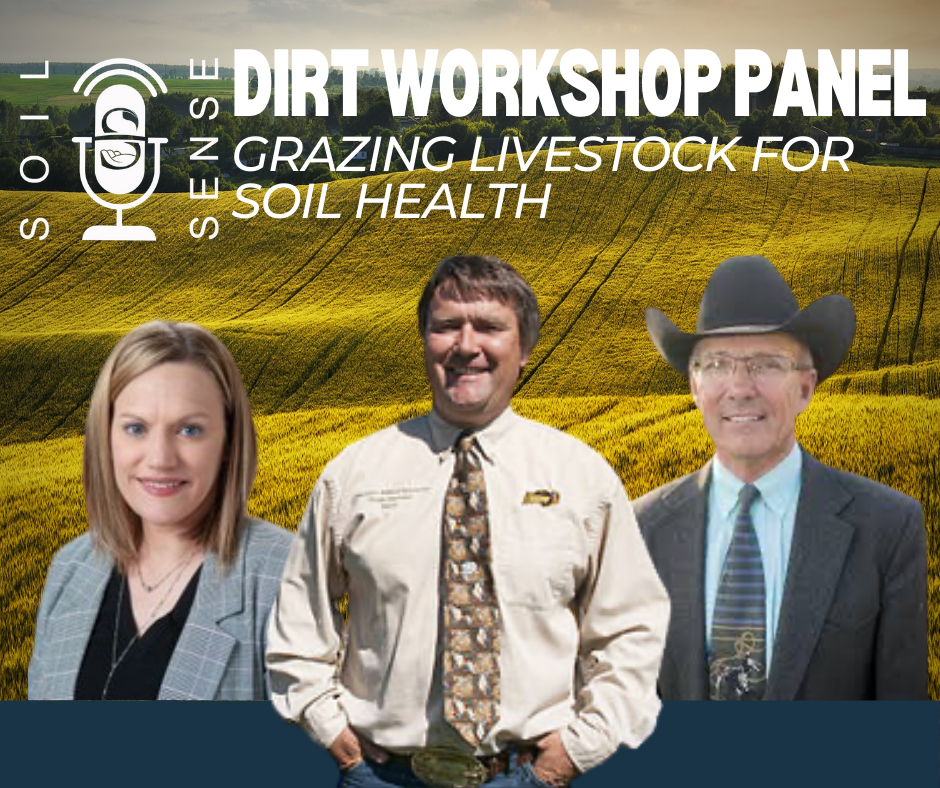
For many farmers on this journey to improve their soil health, incorporating livestock is something they hope to do in the future. This can and will introduce a whole new layer of complexity into the system. How many cattle are appropriate? What will they need in terms of fencing, water, etc.? What will the benefits be to the land? What should be considered in an economic arrangement with a rancher? These were some of the questions discussed on our grazing panel at the DIRT Workshop.
Today you’ll hear from:
- Kevin Sedivec, Extension Rangeland Management Specialist at North Dakota State University Extension and Director of the Central Grasslands Research Extension Center
- Miranda Meehan, Extension Livestock Environmental Stewardship Specialist also at NDSU
- Jerry Doan, rancher from McKenzie, ND
Also on this panel was Mary Keena, Extension Livestock Environmental Management Specialist at NDSU. But you won’t hear from Mary today, as we’re going to do a full episode with her on compost and manure later in this season.
“Just the idea of the hoof action and the urine and the manure that creates this different micro-population that adds a new value and a new component that then benefits your soil microbic population, which then helps you break down and create more organic matter in time. So livestock to me is one of those tools that in my opinion has been a no brainer to add. It’s a quick way to add economic return on that land base.” – Dr. Kevin Sedivec
Dr. Sedivec goes on to highlight that long term management adjustments should be seen as a long term investment. “Don’t expect to see dollar savings the first year you do this.” Continuing soil health practices and incorporating livestock over multiple years will provide the best benefit for producers. Admittedly, it is a complicated process to isolate the value the livestock bring to the cropping system and the cropping system brings to the livestock. Dr. Miranda Meehan is involved in research to better define and answer that problem. Her studies focus on the “carrying capacity” of fields that incorporate the type of cattle to be added, the life-stage they are in, the length of time for grazing and the amount of cover crop residue the producer wants to maintain. She also offers how to choose the appropriate cover crop mixture that works well for your operation and helps “increase nutritional quality and maintain the nutritional plain” for the grazing livestock.
“You know, people ask me all the time, can I build soil health without livestock? And I say, yeah, sure, you can, but you’ll get there 10 times faster with livestock.” – Jerry Doan
Doan’s operation has three main goals at the moment; trying to reduce winter feed costs, increasing the soil health of his crop lands and incorporating wildlife preservation into his operation. Doan shares all the many signs he has seen on his land that indicate increased soil health including worm populations and better granulated soil.
This Week on Soil Sense:
- Meet Dr. Kevin Sedivec an Extension Rangeland Management Specialist at North Dakota State University Extension, Dr. Miranda Meehan an Extension Livestock Environmental Stewardship Specialist also at NDSU and Jerry Doan a rancher from McKenzie, ND
- Learn about the protocols and practices involved in incorporating livestock into a cover crop operation
- Explore the practices producer Jerry Doan has found to be successful with his livestock and cover crop operation
Connect with Soil Sense:
Soil Sense Podcast is hosted by Tim Hammerich of the Future of Agriculture Podcast.
Episode 5 – Managing Salinity and Sodicity
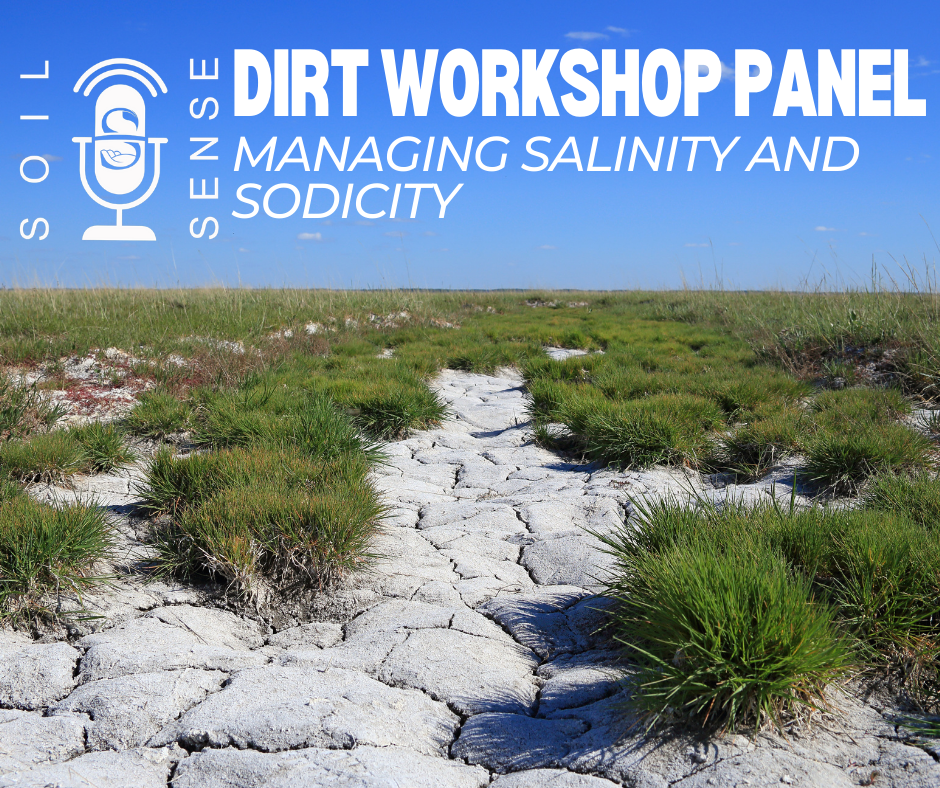
Over 90% of producers in North Dakota are experiencing some sort of reduced productivity as a result of salinity. This problem is not unique to North Dakota – it’s happening in many of our most productive agricultural regions. The second problem that we’re going to discuss today, is a separate problem, but in many cases, even more difficult to manage, sodicity. Sodicity can also impede progress in solving salinity issues. Salinity and sodicity are different soil chemistries and require different management strategies. We discussed these topics on our panel at the DIRT Workshop.
Today you’ll hear from:
- Naeem Kalwar, Extension Soil Health Specialist at North Dakota State University
- Cheryl Reese, Senior Lecturer in agronomy at South Dakota State University
“The reason we need to care about soil salinity and for that matter sodacity too….is because we lose hundreds of thousands of dollars every year on these kind of spots.” – Naeem Kalwar
With the amount of expense necessary to farm ground including gas prices, land prices, inputs and seed prices, having certain sections that represent a net loss can be detrimental to finances. There are corrections that can be made to improve those soils, improving their profitability and move present salts deeper to cause less harm to crops. Naeem suggests first soil sampling to identify what crops and practices will be most successful in those specific areas.
“Across South Dakota and North Dakota, we have very similar soils and these areas pop up because we have old salty sediments that are from old formations. And if these formations are close to the surface and we have a high water table, then these salts will always come back up to the surface.” – Dr. Cheryl Reese
Dr. Reese highlights the benefits of using perennial salt tolerant grasses to improve erosion and salt concerns while still producing a usable crop. She suggests contacting your local NRCS to get more guidance and assistance with that measure. Dr. Reese also echoes Naeem by emphasizing the importance of soil testing to identify the specific issue and its severity before discussing mitigation practices such as switching crops, adding tiles or adding amendments.
This Week on Soil Sense:
- Meet Naeem Kalwar, Extension Soil Health Specialist at North Dakota State University and Cheryl Reese, Senior Lecturer in agronomy at South Dakota State University
- Learn about the harmful effects of salinity and sodicity and what practices can be used to better manage areas affected by these issues
- Explore the potential benefits and limitations of adding tiles and additives to correct salinity and sodicity concerns
Connect with Soil Sense:
Soil Sense Podcast is hosted by Tim Hammerich of the Future of Agriculture Podcast.
Episode 6 – Intercropping and Relay Cropping
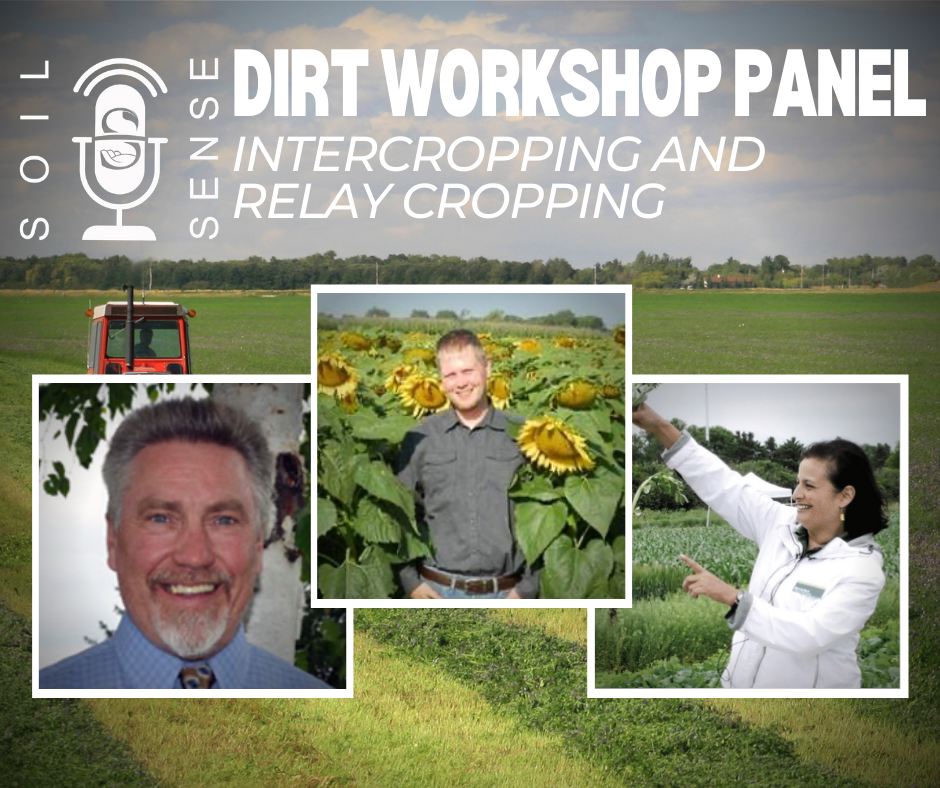
The idea of intercropping – or growing two crops at once, has theoretical appeal of creating synergies for pest and disease management, fertility, and overall productivity. But is this really possible in practice? In today’s episode we talk to three applied researchers about what the data shows when it comes to intercropping and relay cropping. We will explore a few different intercropping and relay cropping combinations, the benefits and tradeoffs, and what to consider before trying any of these systems. This audio was taken from the DIRT Workshop this past fall.
Today you’ll hear from:
- Mike Ostlie a research agronomist at the NDSU Carrington Research and Extension Center.
- Marisol Berti a professor in the plant sciences at NDSU
- Russ Gesch a research plant physiologist with USDA ARS in Morris, MN
“When we have more than one crop growing in the field, I think the first thing you have to realize is you’re not looking to maximize the yield of either of what you’re growing. You’re looking for more total yield.” – Dr. Mike Ostlie
It’s important to keep this in mind because producers will likely see some decrease in yield in both crops as opposed to planting them as a single crop. Overall you should appreciate an increase in the efficiency per acre by achieving an overall production increase between the two crops. Dr. Ostlie does suggest identifying a “dominant crop” in order to best target your management practices and meet your individual needs and goals.
Dr. Berti introduces us to the concept of relay cropping. While intercropping involves planting and growing two crops concurrently with the same expected harvest timing, relay cropping involves overlapping life stages of two crops with separate harvests. Dr. Berti sees a lot of benefit in a corn/alfalfa system she is researching. Alfalfa is not profitable during its seeding year but will be the following year so overlapping with another crop allows for ongoing production while waiting for the alfalfa to mature. The biodiversity, nitrogen fixation and improved water infiltration of including the alfalfa will also benefit the overall soil health while producing a concurrent cash crop.
“I don’t think farmers should be afraid to try (camelina) out and use it as a cover crop even if they’re not going to grow it out to maturity and harvest it because it does have some good cover crop benefits and ecosystem services that it provides.” – Dr. Russ Gesch
Dr. Gesch shares that markets are emerging making the use of intercropping prospects like camelina more profitable for producers. In the meantime benefits such as biodiversity, supporting the insect ecosystem and suppressing weed growth can be of great benefit for producers. All of our experts advise producers to trial these methods on their operations in small amounts at first to limit potential risk while evaluating and adjusting for the most benefit.
This Week on Soil Sense:
- Meet Mike Ostlie, a research agronomist at the NDSU Carrington Research and Extension Center, Dr. Marisol Berti, a professor in the plant sciences at NDSU and Dr. Russ Gesch, a research plant physiologist with USDA ARS in Morris, MN
- Discover and define the benefits of intercropping and relay cropping
- Explore the available options for operations and the many ecological benefits to incorporating them into production
Connect with Soil Sense:
Soil Sense Podcast is hosted by Tim Hammerich of the Future of Agriculture Podcast.
Episode 7 – Managing Soil pH
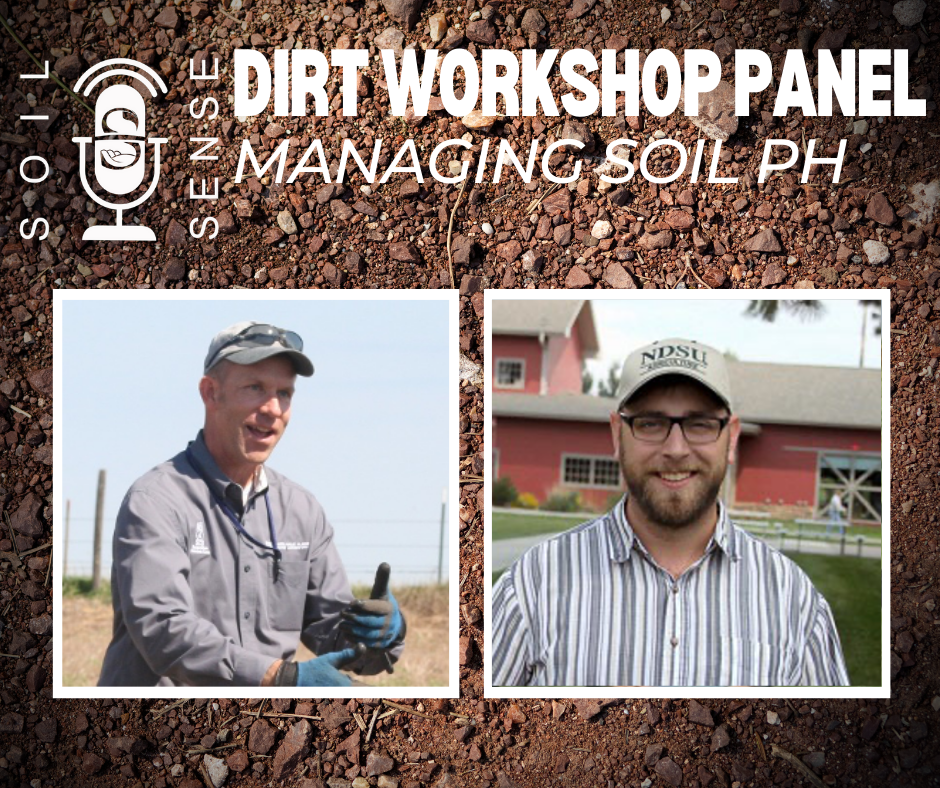
In many cropping systems, the soil is becoming more and more acidic over time. This is happening to some soils quicker than others. A soil with a pH of 5, as an example, is 100 times more acidic than a neutral pH of 7. As these soils become more acidic, they can start to have problems with nutrient availability, nutrient cycling, and ultimately have an impact on yields. And unfortunately, they’re likely to get worse. We talk about what’s causing this acification, some important sampling considerations, ways to fix these problems, and ways to slow the acidification from happening in the first place. Once again, this audio was taken from the DIRT Workshop this past fall. Go check out the youtube links and other podcasts to take advantage of this amazing resource on soil health!
Today you’ll hear from:
- Mark Liebig with the USDA ARS located in Mandan, North Dakota
- Ryan Buetow an Extension Cropping Systems Specialist at the NDSU Dickinson Research Extension Center.
“A lot of the soils that we have in the southwest part of North Dakota, they don’t have the buffering capacity and soil acidification can get real really quick.” – Dr. Mark Liebig
He goes on to say that “we have a widespread global issue with respect to acidification” and that understanding the origin of these issues as well as mitigation efforts that can be made is critical. Sources of decreased pH include rainwater, the mineralization of organic matter, intensive land management with an abundance of applied nitrogen and the aggressive removal of residue on fields. All of these sources in combination make buffering the decreased pH more difficult for the soils to manage with the nitrogen application likely being the most significant. Ryan Buetow highlights the significance of sampling for pH at appropriate depths based on your risk factors. Acidic pH caused by nitrogen is most likely detected near the surface. A deeper sample may dilute the results giving a less representative sample.
“We’ve been trying a lot of different things. The best fix is really a lyming. That’s really what we want people to do with this issue.” -Ryan Buetow
Ryan suggests other “bandaid” type fixes like investigating different varieties of crops and adding strategic phosphorus to bind aluminum that becomes more readily available in a lower pH. Ultimately adjusting the overall pH with the use of lyme, although expensive, is the best way to cause widespread correction of the pH and avoid the potential metal toxicities and herbicide interactions associated with an acidic pH.
This Week on Soil Sense:
- Meet Mark Liebig with the USDA ARS located in Mandan, North Dakota and Ryan Buetow an Extension Cropping Systems Specialist at the NDSU Dickinson Research Extension Center
- Discover different sources that contribute to an acidic pH in the soil
- Learn about different mitigation strategies producers can implement to correct the issue
Connect with Soil Sense:
Soil Sense Podcast is hosted by Tim Hammerich of the Future of Agriculture Podcast.
Episode 8 – Researching the Trade offs of Wide Row Corn
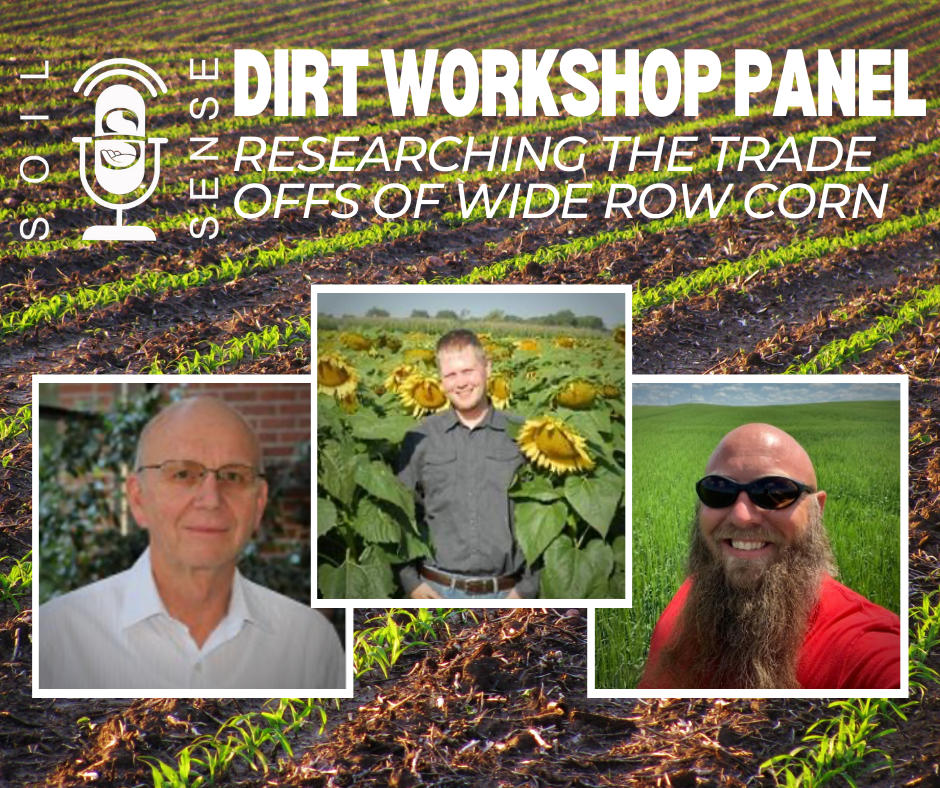
The concept of wide-row corn can seem counterintuitive at first. Why would you make it harder to achieve optimal yields of your primary crop in order to get more production out of your cover crops? Well, collecting the data on these tradeoffs is exactly what today’s guests have been doing – and they have some very interesting results to share. In fact, you’re going to hear varying levels of success with this system, and I think leave this episode with a very realistic sense of what you may be getting yourself into if you try it. Once again, this audio was taken from the DIRT Workshop this past fall. Go check out the youtube links and other podcasts to take advantage of this amazing resource on soil health!
Today you’ll hear from:
- Lee Briese, Agronomist and Crop Consultant with Centrol Ag Consulting
- Mike Ostlie, Research Agronomist at the NDSU Carrington Research and Extension Center
- Joel Ransom, Agronomist with NDSU Extension
“I guess from my perspective, I still see a lot of potential in the system. If we work on the input management and try to economically make the systems a little more equal then maybe we don’t have to get up to the same yield and still make it pencil out just as well.” – Dr. Mike Ostlie
Both Dr. Ransom and Dr. Briese saw a significant decrease in yield that would not be financially sustainable in their current form. Dr. Briese even remarked that producers should be “careful if you try this.” Where the real potential in this system lies is in the integration of livestock according to Dr. Ostlie and Dr. Briese. This allows for additional value in the system by adding another revenue source. Dr. Ostlie goes on to add another benefit this system may afford producers.
“This is really turning out to be probably one of the most flexible options we have in North Dakota and that’s because it allows us to go in there with one or maybe even two herbicide applications in our corn post emergence before we even plant the cover crop. …. It allows us to start with a clean slate in the corn.” – Dr. Mike Ostlie
The system itself is still being defined and developed. All three of our panel agronomists acknowledge that while this is a complicated protocol to use, there is potential for its success for certain operations. At this time more research is needed and planned to fine-tune planting wide row corn.
This Week on Soil Sense:
- Meet Lee Briese a Agronomist and Crop Consultant with Centrol Ag Consulting, Dr. Mike Ostlie a Research Agronomist at the NDSU Carrington Research and Extension Center and Dr. Joel Ransom an Agronomist with NDSU Extension
- Discover the risks and rewards of wide row corn planting
- Learn about what factors may support the profitability of this system, what has been tried so far and what has been found to be most successful
Connect with Soil Sense:
Soil Sense Podcast is hosted by Tim Hammerich of the Future of Agriculture Podcast.
Episode 9 – Manure and Compost for Soil Health

In an effort to build healthier soils, many row crop farmers are caught between wanting the benefits of livestock on their land but also not wanting to enter the livestock business. The decisions are further complicated by whether to pursue grazing livestock, manure or compost. There are many benefits of livestock to be found without the commitment to raising them or partnering with someone else.
To help navigate these options we are joined by Mary Keena, a Livestock Environmental Management Specialist with NDSU Extension based out of the Carrington Research Extension Center. In this episode we explore the benefits of incorporating compost and manure into the soil, how to make it work on your operation, how to get started in composting, and some common pitfalls to avoid.
“As far as our crop production and looking at our soils goes, we want that organic matter back in our soil. And how can we do that?
We add manure. That’s one tool in the box. With that then comes increased water-holding capacity and increased structure for our soil. And so we’re, we’re adding a lot of other benefits besides just the fertilizer…. We’re adding a little bit of microbes to the soil as well through our manure or compost.” – Mary Keena
Keena recommends contacting local livestock producers to see if you can collaborate to use their manure. She suggests starting with a small section of your operation to trial the benefits and management of manure use. She welcomes producers to come visit the research centers to see different types of manure and compost use on example plots that they have established. Keena explains the equipment and timing of managing compost and manure. She finds that equipment for turning the product is the largest expense but she offers producers a less expensive alternative.
“If you’re not sold on compost, try it with the equipment that you have on your farm. Do you have a loader? Do you have a skid-steer? Do you have something that you can turn it with? Do that first. And then if you’re like, this is awesome, then go to a turner because it is an investment. But again, it’s kind of another tool in the box and it’s a trade off. How do you want to manage it? Do you want to manage it in the field or do you want to manage it before it gets to the field?.” – Mary Keena
Composting allows management of the substrate into a more consistent product with more active microbes and less risk of adding a weed seed load to your field. Raw manure can produce the same benefits but will need to be managed once out on the field with practices including herbicides to manage an increased weed burden not eliminated with composting. It’s up to the producer which method of management best fits their operation. There are many factors apart from yield producers can hope to see changes including soil structure, organic matter, microbial growth, affordability, decreased inputs and production value.
This Week on Soil Sense:
- Meet Mary Keena, a Livestock Environmental Management Specialist with NDSU Extension based out of the Carrington Research Extension Center
- Discover the many benefits to adding manure or compost to your row crop management
- Learn about the expenses and the possible pay-off from using these products
Connect with Soil Sense:
Soil Sense Podcast is hosted by Tim Hammerich of the Future of Agriculture Podcast.
Episode 10 – The Power of Perennials with Clair Keene, Ph.D.
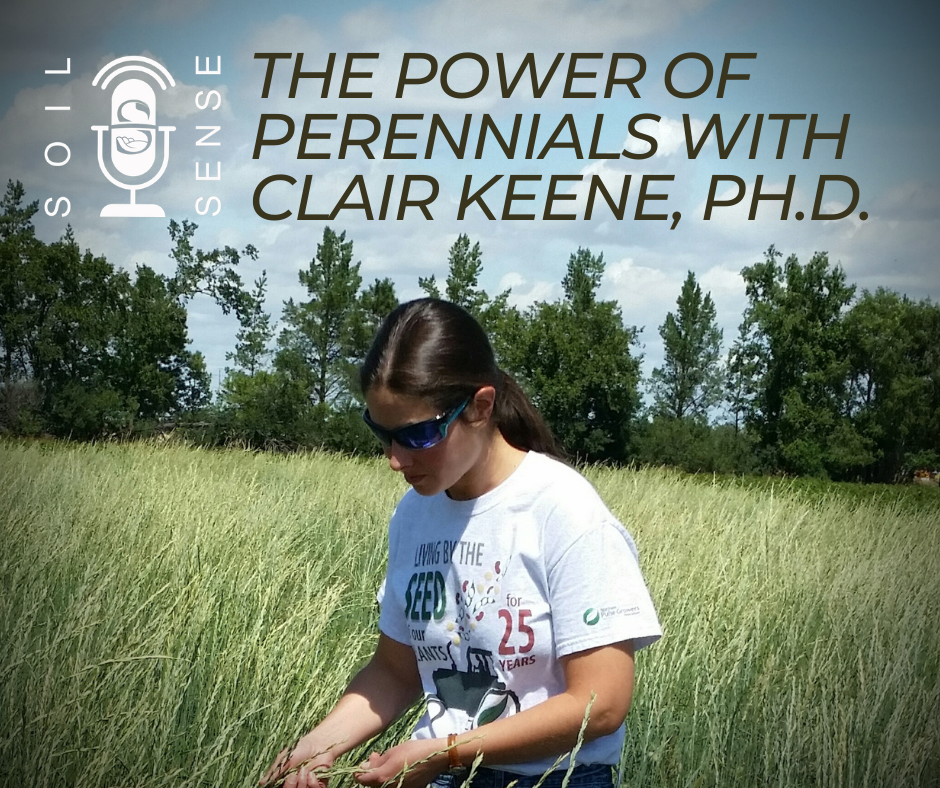
We have a really fascinating episode for you today about incorporating perennials into crop rotations. In the past, we have discussed the many soil health benefits of keeping living roots in the soil year round, diversifying rotations, and minimizing soil disturbance. Perennials are great options for all of the above. Joining us is Dr. Clair Keene, extension specialist in cropping systems at NDSU at the Williston Research Extension Center in northwest North Dakota. Clair shares how she is working with farmers to incorporate perennials for a variety of reasons including managing salts and reclaiming topsoil after pipeline construction. We also discuss the profitability of these crops relative to annual row crops with benefits in decreased inputs and management.
“What some people maybe don’t factor in as they think about maybe how much money they’re not getting in bushels of grain off those acres, but there’s also how many dollars in inputs you’re not spending. You’re not paying for new seed each year and you’re probably not going to be fertilizing it each year. Many stands and perennials once they get going, they don’t even need weed control, so you’re not spraying….So once those perennials are well-established, they’re really taking care of themselves.” – Dr. Clair Keene
Mowing and bailing can become the major annual expense with a good forage for livestock feed as a profitable outcome. With an initial investment in seeding you still can be more profitable overtime than annual cash crops as you “spread the initial costs out” over several years. She goes on to share further benefits including resolving and managing salinity issues in certain locations. These crops better “manage the water table” and keep the water engaged in the plant life cycle rather than evaporating and leaving salt behind. Kernza is an up and coming intermediate wheat grass that has been selected for grain characteristics. The hope is to get a harvest for three to four years and not to need tillage or fertilization resulting in a “potentially very big cost savings.”
“I’m excited about it because of the potential flexibility it offers.…. Because kernza has been specifically developed for its soil health benefits, there’s already a small, but strong and growing niche market that wants to buy the grain. There is a lot of interest in kernza grain.” – Dr. Clair Keene
This Week on Soil Sense:
- Meet Clair Keene, extension specialist in cropping systems at NDSU at the Williston Research Extension Center in northwest North Dakota.
- Discover the many soil and financial benefits of using perennials to manage salinity and overall soil health
- Learn about the development and potential of Kernza as an additional perennial crop that can share these benefits
Connect with Soil Sense:
Soil Sense Podcast is hosted by Tim Hammerich of the Future of Agriculture Podcast.
Episode 11 – Integrated Pest Management and Soil Health
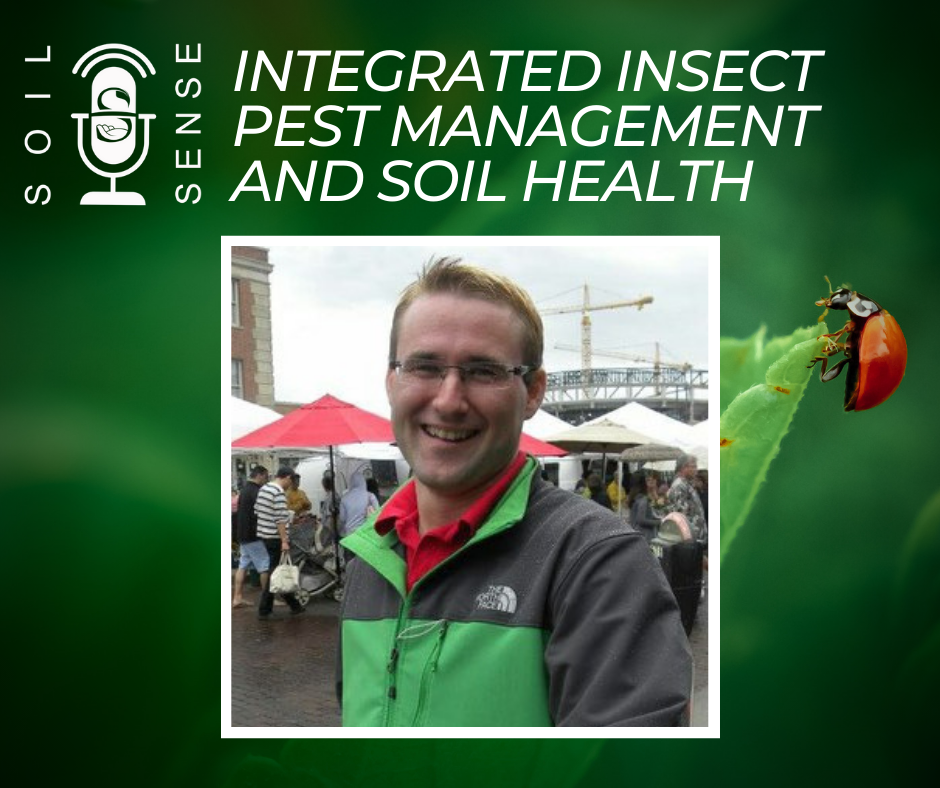
An important part of building healthier soils is focusing on the biology living in those soils. This of course includes the microbes in the soil, but also the plants, animals, and insects that they interact with. In this episode specifically, we’ll talk about how to bring an integrated approach to insect pest management and even some insects that are particularly beneficial to soil health. Joining us is Dr. Travis Prochaska, an entomologist and a crop protection specialist for NDSU extension located at the North central research extension center in Minot, North Dakota. His day-to-day focuses on answering insect related questions and plant disease questions for both farmers and homeowners. He shares with us the integrated pest management approach to managing insects which is becoming increasingly important as resistance is building to some of our chemical controls.
“So (integrated pest management) is the toolbox that we have at our disposal that we can use to counteract the harmful effects of insects in the field.” – Dr. Travis Prochaska
These tools include the most common involving chemical inputs but also incorporate cultural practices, genetic selection for resistance and biological controls. Planting times, variety selection and using beneficial insects all fall under this integrated approach.
There are some insects that are able to not only combat harmful insects but can provide benefits to soil health. Dr. Prochaska highlights the importance of not only scouting for harmful insects but also beneficial insect species to know how best to manage your operation. Beneficial insects such as dung beetles when used within grazing operations can facilitate decomposition of manure into nutrients back into the soil. Using insecticides without taking into account chemical resistance, beneficial insects and the ramifications of the persistence of those chemicals in the environment could be doing producers a greater disservice than benefit.
This Week on Soil Sense:
- Meet Travis Prochaska, an entomologist and a crop protection specialist for NDSU extension located at the North central research extension center in Minot, North Dakota
- Discover what is meant by an integrated pest management approach and the many factors that need to be taken into account
- Learn about the many tools in the tool box of integrated pest management and the pros and cons to each
Email Dr. Prochaska to participate in the virtual workshop series coming up discussing insect control and management.
Connect with Soil Sense:
Soil Sense Podcast is hosted by Tim Hammerich of the Future of Agriculture Podcast.
Episode 12 – Soilborne Diseases
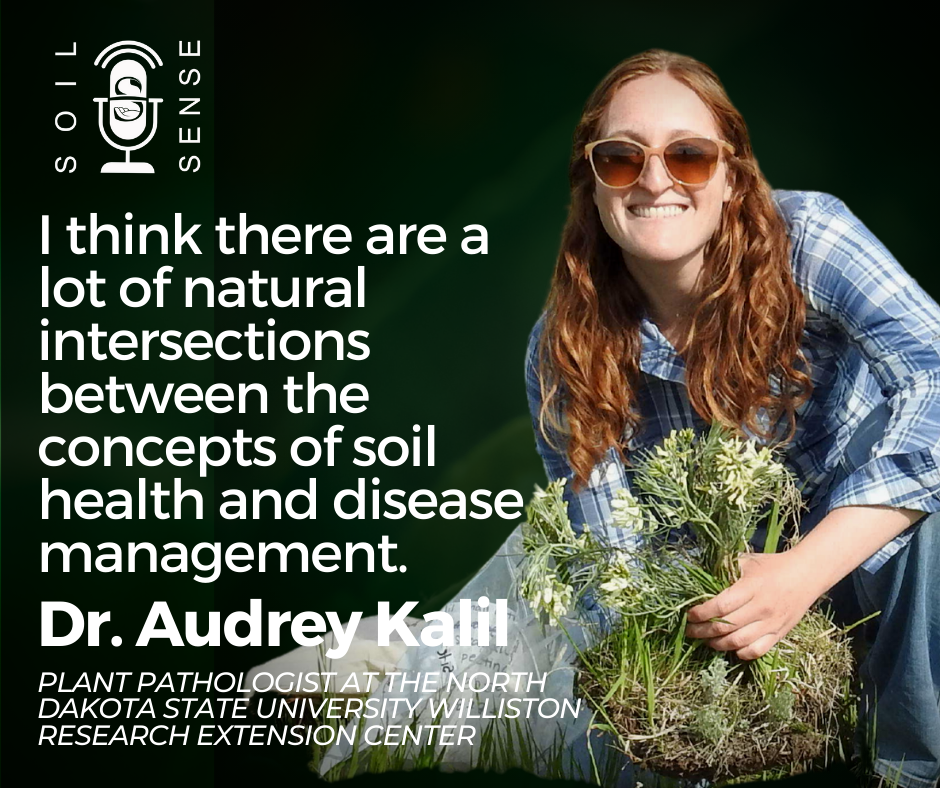
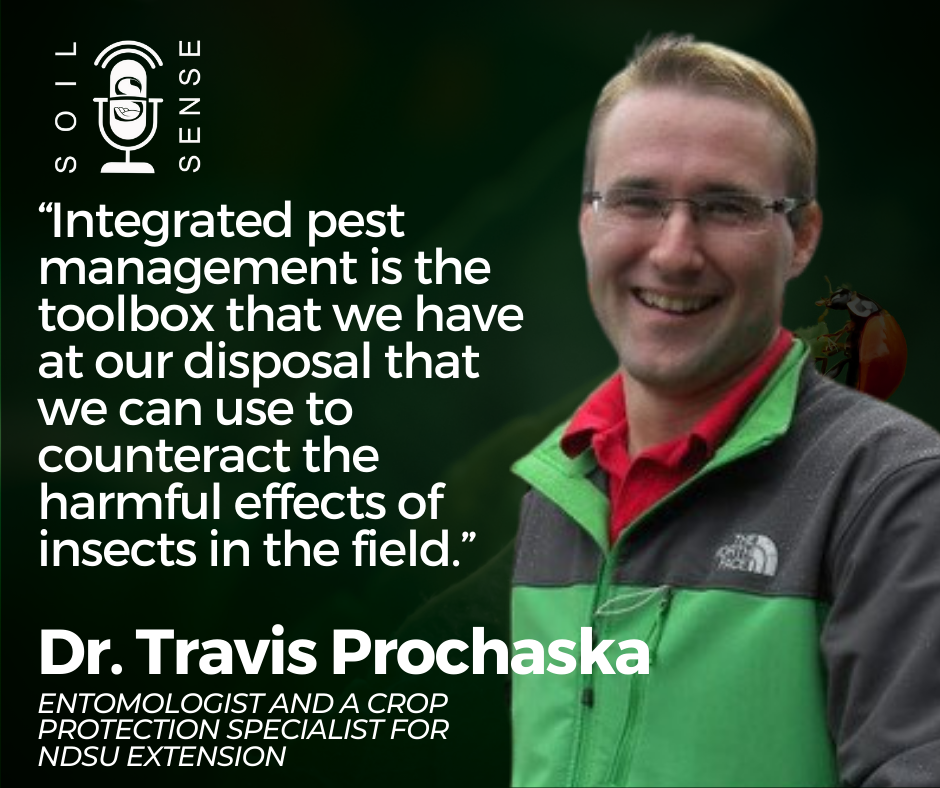
As with any biological system, there can be good microbes, and there can also be harmful microbes. Crop and soil health is certainly no exception. In this episode we will discuss some of the soilborne pathogens that are impacting crops, with a special focus on pulse crops (peas, lentils, and chickpeas).
Dr. Audrey Kalil, a plant pathologist at the North Dakota State University Williston Research Extension Center joins us. Audrey’s research focuses on common crops in the region, which is a pretty dry area, so crops like spring wheat, durum wheat, canola, and pulse crops. Most of her work is in looking at soilborne diseases. But Audrey didn’t always set out to study diseases. In fact, her PhD work focused on the beneficial nitrogen-fixing types of bacteria. It also explains how she found a particular interest in pulse crops.
“I think there are a lot of natural intersections between the concepts of soil health and disease management.” – Dr. Audrey Kalil
Dr. Kalil shares how pulse crops through cover crop usage and rotation strategies can help many operations. She goes on to share the necessity and advantage of providing a “robust microbial ecosystem” to help your soils not become burdened by any one pathogen or disease. Dr. Kalil highlights that some crops overlap with pathogens they may promote for example peas and lentils. The overlapping characteristics of these species can lead to an overgrowth of some soil pathogens that will become more difficult to manage overtime. She offers different management strategies and seed treatments to avoid these overgrowth situations.
Dr. Kalil explains the disease triangle as a concept to better understand crop disease management. There are three main pillars to developing crop disease including the presence of the pathogen in your area, the variety of crop and its level of susceptibility and the effects of weather. Managing and manipulating any one of these pillars can lead to a lower crop disease burden and his a helpful way to address these concerns.
This Week on Soil Sense:
- Meet Audrey Kalil, a plant pathologist at the North Dakota State University Williston Research Extension Center
- Discover what advantages nitrogen fixation bacteria can offer different operations
- Learn how to encourage biodiversity in the soil microbial heath as a soilborne pathogen deterrent
- Explore they many different techniques available to manage crop disease
Learn more about pulse crops by listening to the Growing Pulse Crops Podcast
Connect with Soil Sense:
Soil Sense Podcast is hosted by Tim Hammerich of the Future of Agriculture Podcast.
Episode 13 – Pheasants Forever and Soil Health
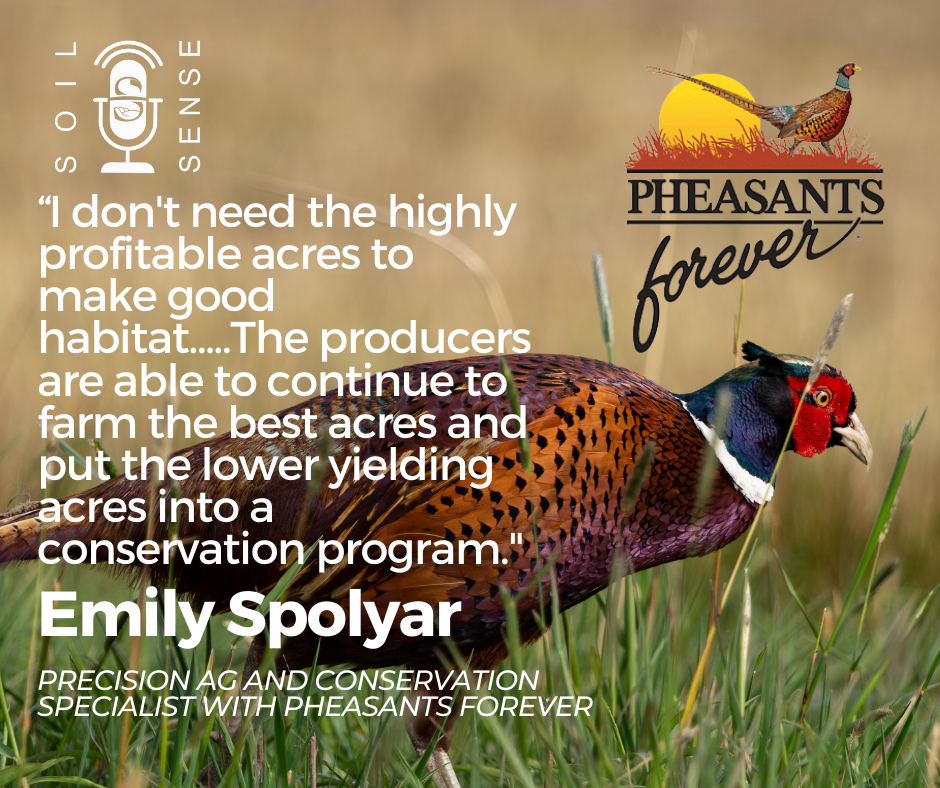
This podcast has always been about collaboration and building healthier soils while promoting productivity and profitability at the farm level. It’s definitely a team effort.
Today’s episode shines a spotlight on the work being done by Pheasants Forever and why they too are passionate about building healthier soils. Their primary goal is to “conserve pheasants, quail, and other wildlife through habitat improvements, public access education and conservation advocacy.” As part of their mission to create better bird habitat, their strategies and programs for producers and landowners align really well with others involved in soil health management. Joining us are Austin Lang and Emily Spolyar, both are precision ag and conservation specialists with Pheasants Forever located in North Dakota.
“We’ve seen through research and experience that habitats have been the most effective and cost-effective way to get to that mission.” – Austin Lang
The first step in their process is identifying the goals of the producer and landowner. There are many options regarding limiting public access and various programs to best meet those goals, some of which are specific for certain areas like”watersheds or geographies.” Some programs generate revenue with rental payments while others may allow for grass seed or cover crop compensation. Emily shares that through analysis she can identify acres that are underproducing and may be a good option to support bird wildlife. A collaborative project like this may also provide financial benefit to the landowner and keep the producer from farming acres that are ROI negative.
“I don’t need the highly profitable acres to make good habitat. So let’s put (habitat) in places that make sense. So (the landowner) is still able to enjoy hunting on those acres and then the producers are able to continue to farm the best acres and put the lower yielding acres into a conservation program.” – Emily Spolyar
They have seen improvements of course in wildlife habitats but also compaction issues, salinity issues, overall soil health and of course financial gains. “Everything that we do is all farmer led. However they want to proceed is what we go with,” shares Emily. Austin was sure to highlight that they are in no way replacing producers’ agronomist relationships but rather aim to add value and offer another resource for producers to have access to.
This Week on Soil Sense:
- Meet Austin Lang and Emily Spolyar, both are precision ag and conservation specialists with Pheasants Forever located in North Dakota.
- Learn about the programs Pheasants Forever offer producers and landowners that can improve soil health and farm economics
- Explore the process and the experts they employ to find the best fit for each piece of land through their precision agriculture outreach
Connect with Soil Sense:
Soil Sense Podcast is hosted by Tim Hammerich of the Future of Agriculture Podcast.
Episode 14 – Agronomic Challenges and Soil Health Opportunities
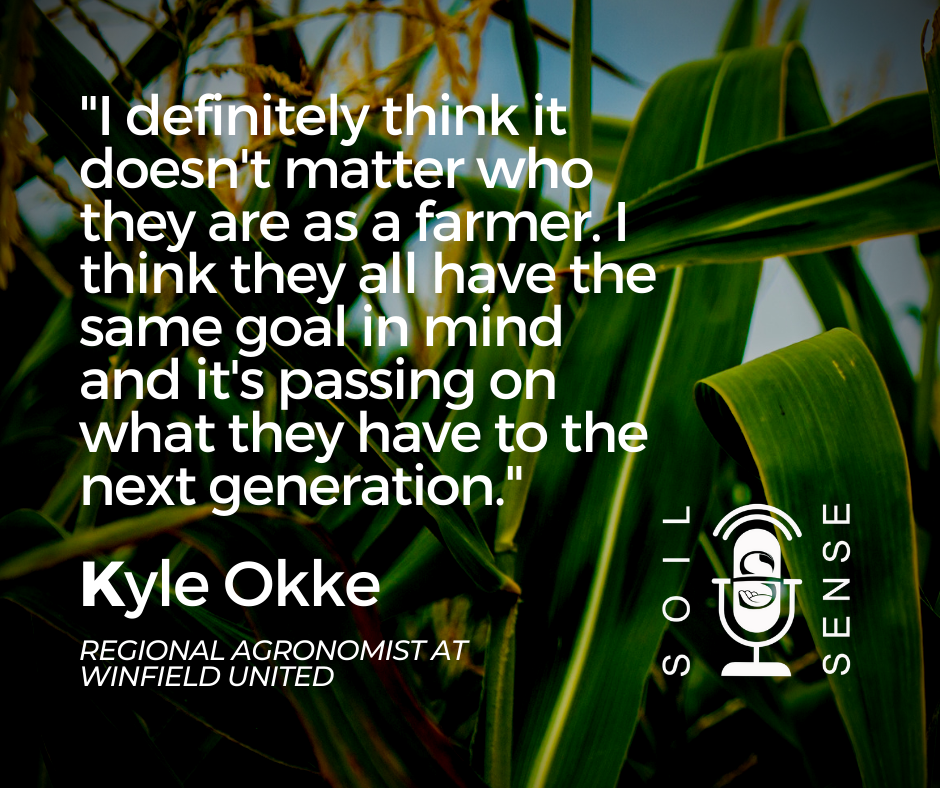
On the show today is Kyle Okke, regional agronomist at Winfield United. Most listeners are familiar with Winfield United, the large ag retail network that is part of Land O Lakes, a member-owned cooperative. Kyle is responsible for being a technical resource on anything related to crop protection, which includes employee training, customer education, troubleshooting, and technical advice. His job is impressive both in it’s scope of responsibilities, but also in its geography. Kyle covers from the Red River Valley all across North Dakota and Montana. With his experience of working very different areas of the state agronomically, he’s seen where farmers are generally the same, and where things are different.Today we navigate a variety of topics from tillage to carbon to pH to mistakes he’s seen some farmers make in a dry year like this one.
“I definitely think it doesn’t matter who they are as a farmer. I think they all have the same goal in mind and it’s passing on what they have to the next generation….You can’t just mine your soil, deplete it of all its nutrients, and deplete it of all its resources. ” – Kyle Okke
He is seeing a trend with producers increasingly focusing on balanced fertility programs, better moisture retention, and making adjustments to retain as much topsoil as possible. Whether the producer wants to call it “soil health” or not the objective is to prolong the viability of ground they have available to farm. He has observed a lot of success and increasing popularity with strip tilling practices as a compromise between better agronomics and soil health. He cautions producers from focusing on any one factor as an individual. For example, increasing carbon levels without adjusting for the carbon to nitrogen ratio. The concern here is that increased crop residue that leads to increased carbon in the soil will also temporarily tie up nitrogen in the soil. So rather than focusing on the carbon by itself, looking at the carbon as part of a system seems to be a better use and adjustment for soil health. He offers his opinion on carbon credits in light of this opinion.
“The big thing is that this is incentivizing good soil health practices. That’s what I see behind it is that it’s an incentivization to do the right thing, you know, just to start building soil health.” – Kyle Okke
As a final note, Kyle shares that he sees technology as a significant investment that will have a good return in the long term for producers. “I think technology is really going to pay for those guys that are adopting it and utilizing this data that they’re collecting.”
This Week on Soil Sense:
- Meet Kyle Okke, regional agronomist at Winfield United
- Learn about his experience and observations of trends working across the states of North Dakota and Montana
- Explore his views on different agronomic practices from a high-level systems perspective rather than looking at one nutrient or factor at a time
- Be sure to listen to The Agronomist Happy Hour Podcast that Kyle co-hosts. He recommends the episode called Complaints and Cocktails
Connect with Soil Sense:
Soil Sense Podcast is hosted by Tim Hammerich of the Future of Agriculture Podcast.
Episode 15 – Soybean Cyst Nematode
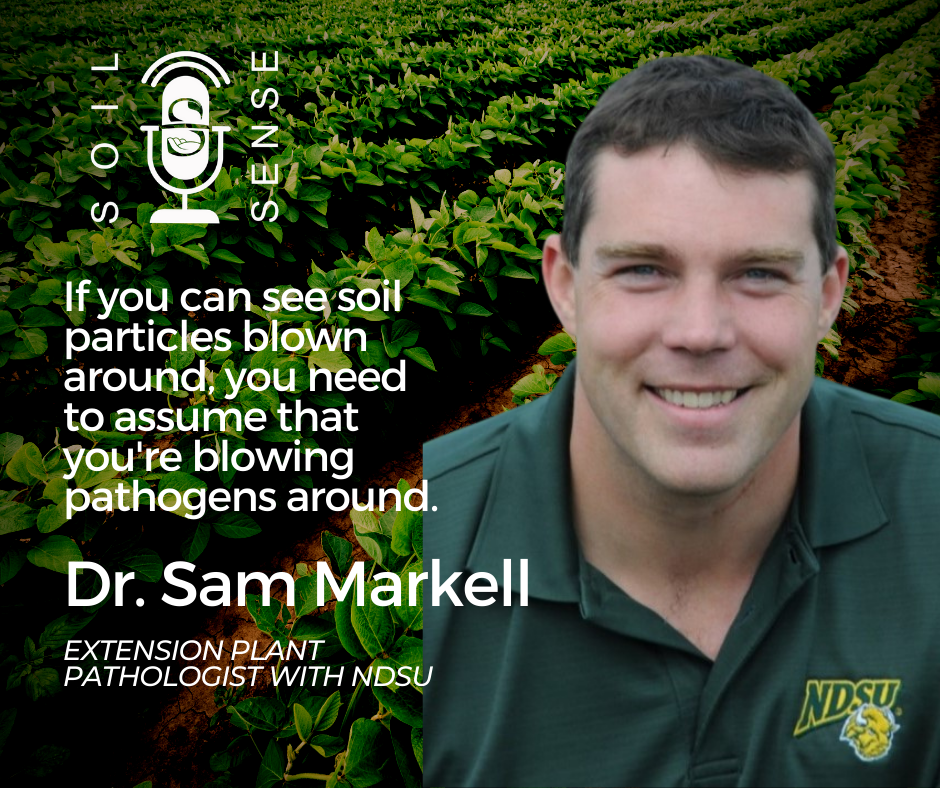
In the fourteen years that Dr. Sam Markell has been in his current position as extension plant pathologist at North Dakota State University, he has not only seen an expansion in soybean acreage, but also in soybean diseases and nematodes. Well, one nematode in particular. You’re going to hear Sam mention several diseases throughout the course of today’s conversation. You’re also going to get a fascinating conversation about why knowing your soils can help you manage soil pathogens, and a science-fiction like idea of fighting these diseases in the future.
For the most part we’re going to focus on two of the main problems: soybean cyst nematode and sudden death syndrome. Dr. Markell has observed the adaptation of the nematode causing soybean cyst disease to previous varieties that were once resistant. The same genetic resistance was used in common soybean varieties and after years of efficacy it is now showing susceptibility in specific locations. However, that susceptibility is likely to spread.
“Particularly with pathogens, they’re microscopic for the most part so you can assume they’re light. If you can see soil particles blown around, you need to assume that you’re blowing pathogens around.” – Dr. Sam Markell
Sudden death syndrome is caused by a fungus and can also be spread through soil transfer. While the fungus will not leave the roots they infect they will produce a toxin that affects the entire plant. Dr. Markell shares that seed and variety selection is one of the most crucial management strategies for disease management. He also highlights the efficacy of extending crop rotations to reduce the pathogen load in the soil.
“We know for sure that we will always have invasive pathogens. We also know that the pathogens we do have, they are going to adapt. They are going to change. They’re going to evolve. They’ll mutate, they’ll increase in different ways…. We can handle them really poorly or we can handle them really well.” – Dr. Sam Markell
This Week on Soil Sense:
- Meet Sam Markell an extension plant pathologist at North Dakota State University,
- Explore the expansion of the soybean crop in North Dakota and the diseases they are susceptible to
- Discover different management techniques to best control soybean cyst nematodes and sudden death syndrome
Connect with Soil Sense
Soil Sense Podcast is hosted by Tim Hammerich of the Future of Agriculture Podcast.
